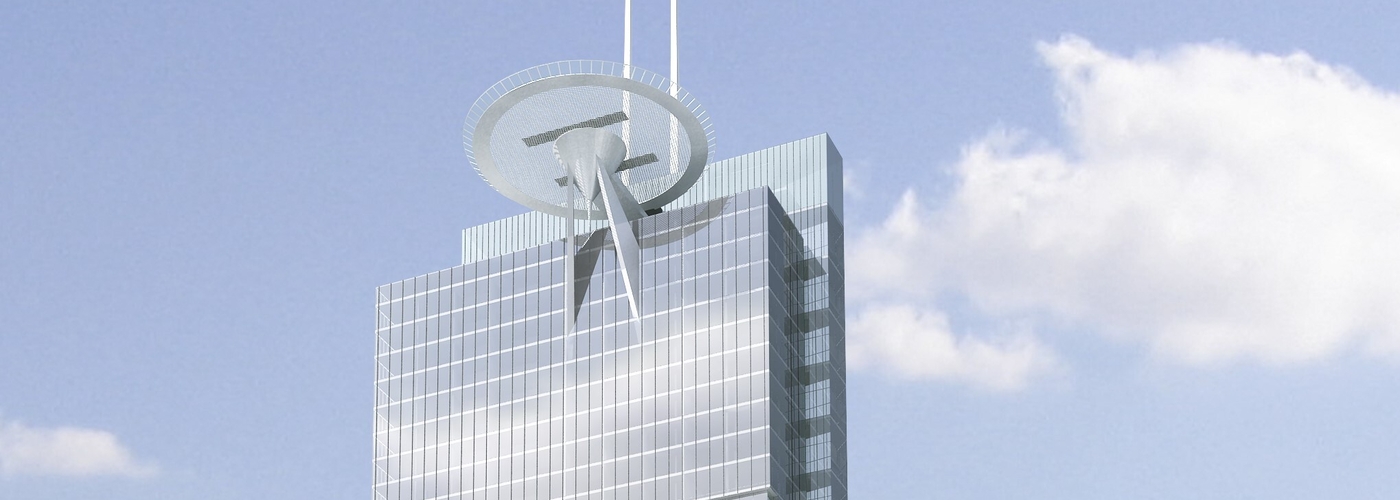Jonathan Schofield with some examples of skyhigh failures
We've got six of the best failed tower schemes here and there'll be another six next week.
The Manchester and Salford towers keep on coming. Nearing completion is Renaker’s 154m (505 ft) circular Three60 at Deansgate Square and still with a bit to do yet is Salboy’s 138m (455 ft) Viadux rearing up next to Beetham Tower.
Down at Trinity Island, at the Regent Road border with Salford, another couple of tall buildings are under construction with the tallest being 169m (554 ft).
All very good, all very Thunderbirds but it never happened, instead a less mobile solution for a heliport was sought
More giants are being planned, two of which will be higher than Deansgate Square’s 201m (659ft) South Tower, the city’s tallest at present and the tallest building outside London.
Henley Investment Management are scoping a tower that will be the third tallest in the kingdom at 264m (866ft) on the site of Regent Road retail park, while back at Deansgate Square, Renaker again, want to deliver a 213m (699ft) giant.
But throughout Manchester’s history there have been towers that never made it. Here’s a list of six old and new towers none of which were designed by Manchester practice Simpson Haugh unlike all but one of those mentioned above.
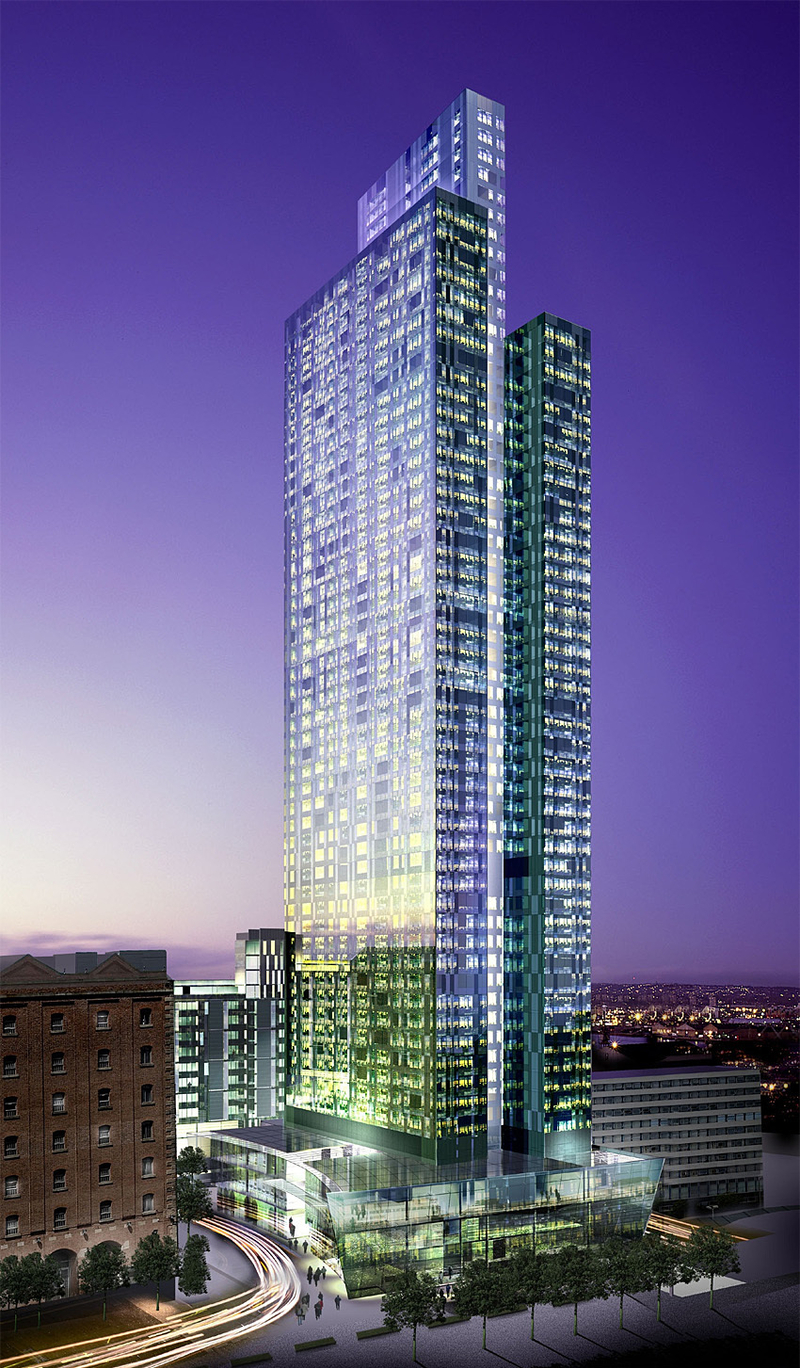
Eastgate Tower
Date 2005
This tower, designed by Australian architects, Woods Bagot, bit the metaphorical dust with the recession at the end of the noughties. It would have been easily the tallest Manchester skyscraper to roofline at 188m (620ft) until Deansgate Square's South Tower at 201m (659ft). As with Beetham Tower it was to be a hotel on the lower floors and apartments on the upper floors. There would have been 420 residential units and a 220 bedroom hotel alongside a fitness centre, conference facilities, restaurants and bars.
The project pictures show a very finely crafted convex podium upon which the handsome 60-storey tower sits. The tower consists of three strong vertical elements with the central element the tallest. The location for the building was to the rear, the east, of Piccadilly Station on 3.5 acre site with another pair of buildings adding more apartments to make a total of 710. The nearby Ashton Canal would have been landscaped as part of the scheme. The total estimated cost was £220m.
A good deal of money was spent clearing the ground and demolishing existing railway arches but presently the site sits empty, a flattened wasteland with the half life of a surface car park. It lies adjacent to where the high speed link HS2 might one day arrive in Manchester. Might.
After the announcement of the scheme the city’s tourist body, Marketing Manchester, produced a ‘Manchester Bag’, a small sack with wooden cut-outs of key Manchester buildings. Eastgate appears amongst the models although smaller than Beetham Tower. Eastgate therefore briefly achieved an undeserved afterlife.
Heliport Turntable Terminal Ambition
Date 1951
Mad this one. It’s the shadowy plan reported in the Manchester Guardian of 1951 for a ten storey turntable tower exactly where Selfridges and Exchange Square presently sit. The building would have been a rotunda incorporating a cinema, a 250 bedroom hotel, a 300 cover restaurant, shops, showrooms and offices, but mainly it would be a heliport.
The architect was the wonderfully named JJ Spyra from civil engineering firm Taylor and Whalley. Sprya designed the building but told the Manchester Guardian he didn’t think it could be constructed just yet as the right type of helicopter hadn’t been approved, but there was one undergoing trials which might do the trick. That’s real optimism.
The building would have cost £1.5m and needed the hotel and the restaurant and the other elements as chopper landing fees alone wouldn’t provide sufficient return. The site smack bang in the city centre would fulfil all the requirements of the Ministry of Civil Aviation ‘as it is in easy reach of bus and rail termini, and business and shopping centres. A site outside the hub of the city would fail in the primary purpose of bringing within reach of business people inter-city door to door air transport’. Estimated flight times were London and hour and a half, Liverpool twenty minutes. Manchester Airport would be less than ten minutes away rather than the hour it took on terra firma in 1951.
The Ministry thought the idea was ‘really excellent’, especially the cunning part. The 330ft by 250ft landing deck on the roof ‘will be on a turntable, so it can be rotated into the prevailing wind, to provide a run-in 300ft long. The structure will be made of aluminium alloy based on shock absorbing bogies that will run on rails supported on a reinforced concrete gantry 50ft above the roof on the tenth story.’
All very good, all very Thunderbirds but it never happened, instead a less mobile solution was sought. Aside from the noise it’s a shame this project never happened. Even if helicopter traffic had never succeeded, which it didn’t, it could have become central Manchester’s mobile green space, a tenth floor rotating pocket park.

Intercontinental Tower
Date: 2009
This 48-storey tower and hotel would have sat next to the Edwardian Hotel (Free Trade Hall) behind the retained façade of the 1845 Theatre Royal. The façade would have acted as foyer to the hotel providing a rich mix of old and new. It was designed by the Manchester practice Stephenson Bell.
Before it was all scuppered by recession, the building was due to host a five star hotel run by Intercontinental Hotels - hence the name. Interestingly, given the 1950s’ heliport schemes (see above), the idea returned, with this skyscraper featuring a helipad. Unlike the previous scheme this wouldn’t have been for public transport purposes but rather used for millionaire footballers to swish into the rooftop bar.
The two decorative spires on the tower would have carried the height to over 200m (660ft) high, making it the tallest building in the city, although the height of the building proper without the masts would have been 160m (520ft), below that of Beetham Tower and Eastgate Tower.
Presently the neighbouring building to the Theatre Royal, the Edwardian Hotel has stepped in looking to deliver an 800 seat ballroom, ten huge hotel suites and a rooftop bar and restaurant plus a residential element.
Lee House
Date: 1931
The debate about tall buildings is now over in the central areas of the city. Manchester and Salford city councils have decided it's ok to build higher and higher. This was not always the case.
One failed scheme would have given Manchester a glorious ‘skyscraper’ as early as 1931. This would have been a fully realised Lee House on Great Bridgewater Street. Eight storeys were built as a textile warehouse but permission was denied for the magnificent whole.
Although credited to the firm of Harry S Fairhurst, it was, according to an essay by architectural commentator, David Morris, designed by James Henry Sellers with assistance from Edgar Wood. Morris describes how the art deco building would have looked. ‘Brick pilasters, broad at the corners, run the full height of the structure, alternating with canted bronze windows subdivided into ‘leaded lights’ (now replaced). The piers and corners were subtly highlighted using recessed mouldings, and the ground floor and top were faced in Portland stone with art deco ornament. Had it been completed, Lee House would have been one of the highest buildings in Europe.’
Sellers designed the building but the delightful watercolour, with its scurrying citizens, was probably executed by Wood.
The proposed building was discussed in a 1928 article from the Manchester Guardian.
‘The altitude of the proposed new building is understood to be 217 feet - some 80 feet higher than the offices of the Ship Canal company in King Street - the tallest structure as yet erected in Manchester. The wisdom of allowing skyscrapers to be built in streets as narrow as those of Manchester has been questioned in various quarters. Reference has been made from time to time as to the difficulty of dealing in such buildings with outbreaks of fire.
‘But a far graver objection, it is suggested, lies in the fact that any appreciable extension of this kind of building must inevitably lead to a still greater congestion of traffic. Although there can be no doubt that under existing circumstances with a constant increase taking place in site values it is more economic for business houses to extend their premises vertically then latterly. The only solution of the problem, it is maintained, lies in the clearance of the slum areas of the city which would not only provide for a natural and economical expansion of the business centre, but would result in the transference from these wretched areas to more healthy surroundings of the unfortunate folk who at present inhabit them.’
Strangely enough given the rise and the rise of the post-Millennium ‘skyscraper’ that is exactly what has come to pass. Not that housing has been properly sorted out, and in many areas the post-World War II solution of shipping people to isolated council estates failed miserably after a couple of decades.
Although Lee House never achieved its seventeen storeys over worries about fire safety and rows about light infringement, unlike most of the dream towers at least we got part of it completed.
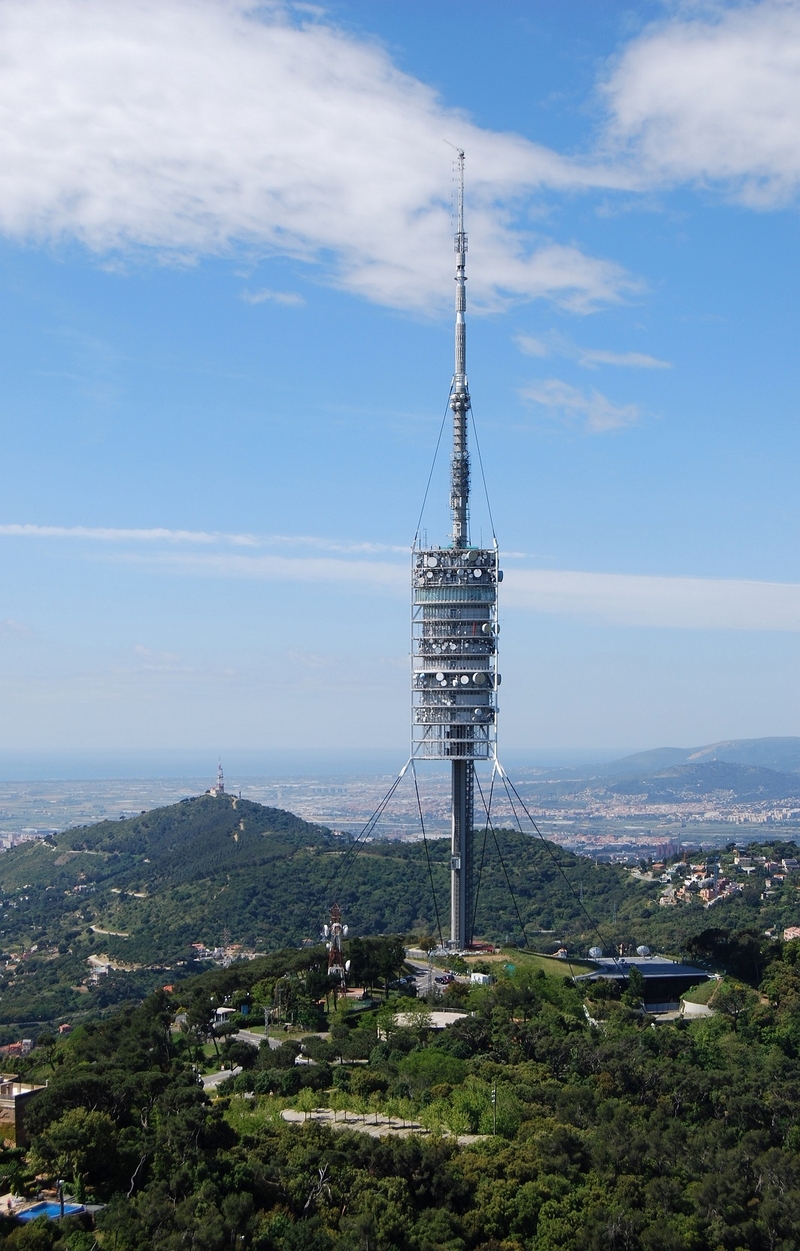
Olympic Communications Tower
Date: 1992
Blueprint Magazine got excited in the 1990s about the changes which might come about should Manchester win the right to hold the 2000 Olympic Games. So they commisioned international designers to come up with some ideas.
Czech-designer Eva Jiricna came up with a glorious 300m (1,000ft) high radio mast located behind Piccadilly Station. The inspiration for the structure is fairly obvious. Barcelona’s Torre de Collserola had been erected to the designs of Mancunian born Norman Foster for the 1992 Olympic Games. Ambitious cities of the time had tick boxes of assets they needed to acquire. Along with concert halls and indoor arenas were Communications Towers.
The simplicity of Jiricna’s design has much to commend it and would certainly have kick-started the redevelopment of a part of Manchester’s city centre which is only now beginning to spark to life.
Blueprint Magazine slapping themselves on the back for their choice of designer wrote, ‘The tower would be the tallest structure in the city, but its light and slender form would enhance rather than dominate the skyline.’ Looking again at the picture on this page it’s hard to disagree with that sentence. This was one idea we let slip.
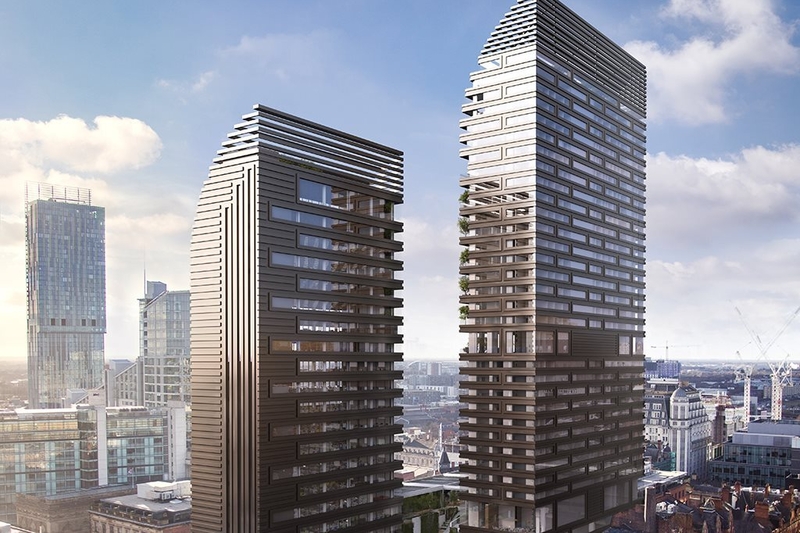
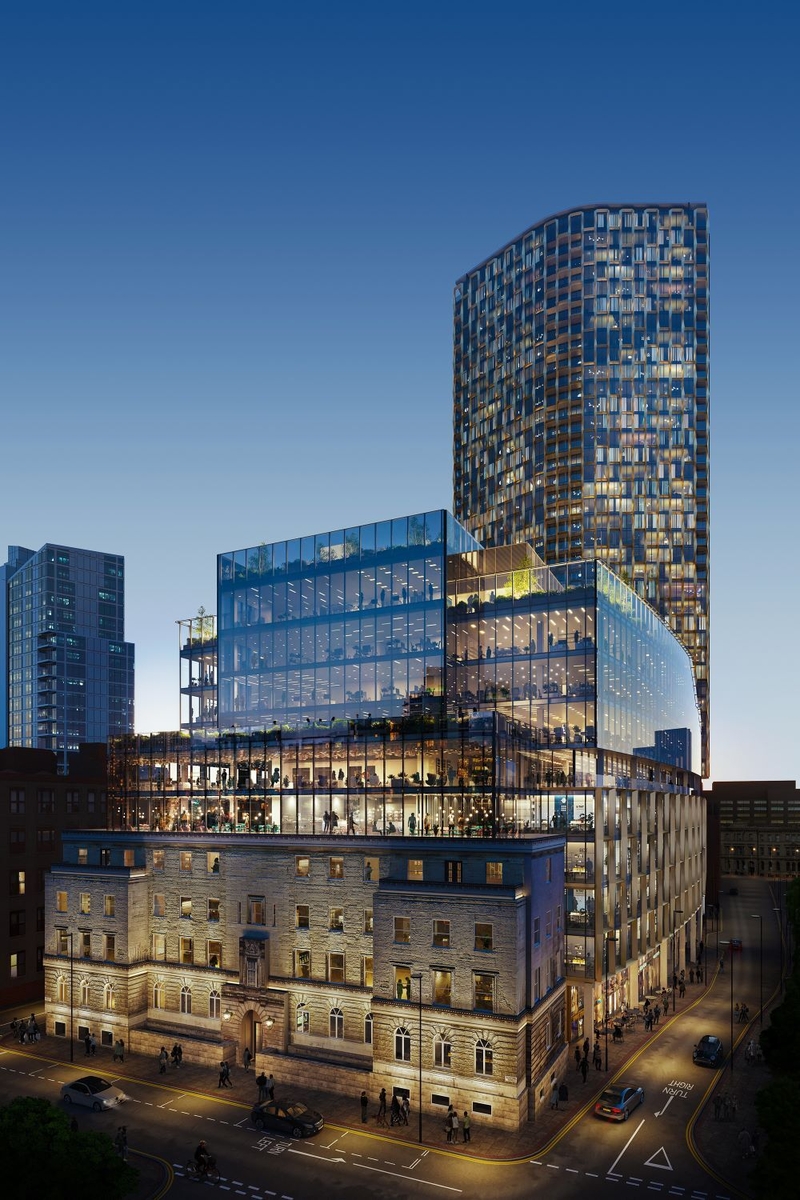
St Michael's Towers - part one
Date: 2016
The objections came immediately to these towers designed by Make Architects. Two large lumpy structures of 31 and 21 storeys dressed in black. It was as though Tolkien's Barad-dur was about to hit town. Twice.
Historic England, the national overseer of heritage, said of the development: ‘It would cause a high level of harm to both the conservation area and the setting of the nationally important civic buildings of the Town Hall and Central Library.’
Petitions to block the development which included the demolition of the former Bootle Street police station facade and the Abercromby pub, gathered almost 10,000 signatures, whilst heritage groups including Historic England, The C20 Society, Save Britain’s Heritage and The Victorian Society all waded in on the scheme.
Even support from the council – which stood to make a huge profit from the scheme (it owns much of the plot alongside GMP) – appeared to wane in March 2017 when Sir Howard Bernstein, former Manchester City Council chief executive and one of the main proponents of the scheme, admitted in interview that ‘the jury is still out (on St Michael's)'.
Instead, Manchester architect Stephen Hodder was appointed, Make Architects ditched, and a single tower was proposed. Construction is due to start soon and this will be 41-storeys (135m, 443ft) with a much higher budget for its external finish than other city skyscapers.
As Stephen Hodder told Confidentials back in 2017: “The verticals of the building will be articulated, cut, carved, faceted and given a bronze-gold finish. Aside from creating a superbly textured wrap, the building will now will throw light off itself in myriad directions as the day progresses and the weather changes.”
That’s the plan anyway. Completion is due sometime in 2027.
Many of these stories appear in Jonathan Schofield's books on the city Lost & Imagined Manchester and Ilusion & Change Manchester, available here.
If you liked this you'll like
Best Brutalist buildings part one
Sunlight House row as heritage features ditched
Britain's most horrifying sculpture
Demand for city centre apartments is still frighteninly high
Get the latest news to your inbox
Get the latest food & drink news and exclusive offers by email by signing up to our mailing list. This is one of the ways that Confidentials remains free to our readers and by signing up you help support our high quality, impartial and knowledgable writers. Thank you!





